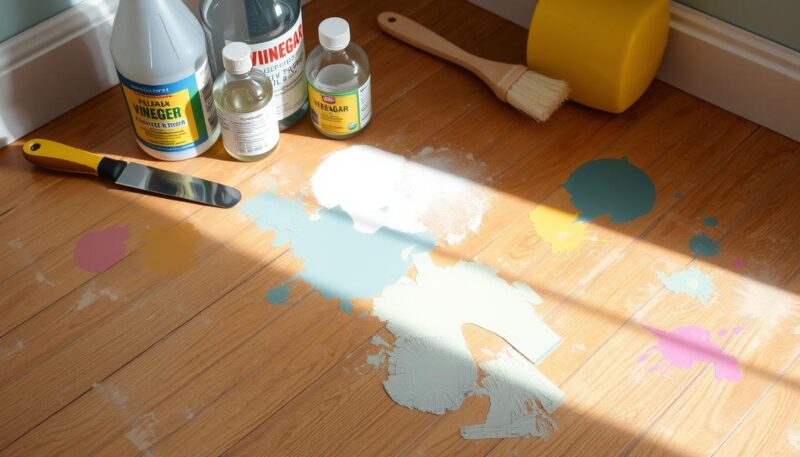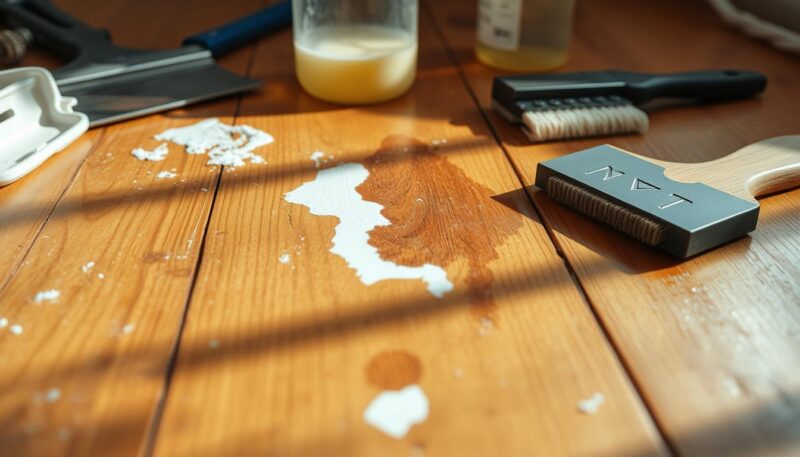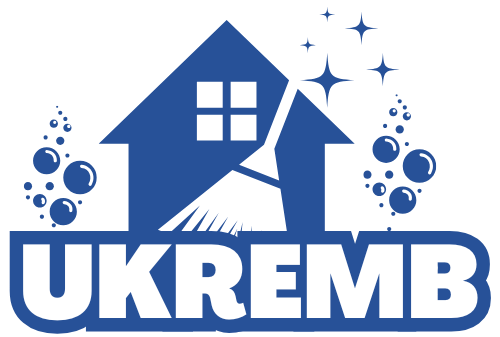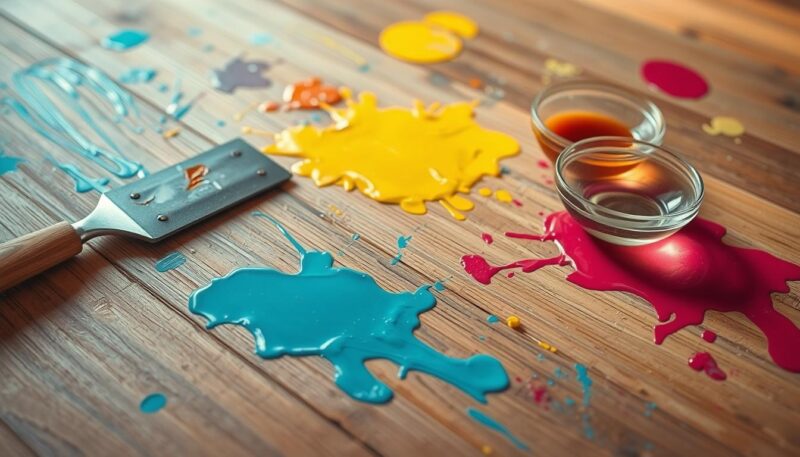Are you dealing with unsightly paint spills on your beautiful hardwood floors? It’s a common issue that many homeowners face, but don’t worry; you’re not alone. Knowing how to get paint off wood floors can be both a challenge and an opportunity to restore your floors to their former glory. With the right paint removal DIY techniques at your fingertips, you can effortlessly tackle both fresh and dried paint stains.
When it comes to paint removal, the type of paint matters significantly. Water-based paints are typically easier to remove than their oil-based counterparts. This introduction will guide you through effective strategies, whether you are addressing a recent splatter or an old, stubborn mark. Essential tools like microfiber cloths and hard plastic putty knives will be your best friends in this endeavor, helping to protect your wood finish while effectively lifting the paint. By understanding the unique characteristics of different paints and employing suitable techniques, you can easily get paint off hardwood and regain the beauty of your floors.
Understanding Paint Types and Their Removal
Understanding the differences between water-based paints and oil-based paints is essential for successful paint removal. Each type presents unique challenges when it comes to how to clean paint spills. Knowing the characteristics of each can help you choose the right approach for your specific situation.
Water-Based vs. Oil-Based Paints
Water-based paints are easier to clean up compared to oil-based paints. When the paint is still wet, it can be wiped away with water and soap. For dried water-based paints, solutions like mixing three parts isopropyl alcohol with one part lemon juice can effectively break down the stain. On the other hand, oil-based paints, once dried, require more robust cleaning methods. If you notice no residue on a cotton ball moistened with isopropyl alcohol, it likely indicates you are dealing with oil-based paint, which may require specialized products for removal.
Testing Paint Type
Identifying the type of paint you are dealing with is crucial before beginning any cleaning process. To test, dampen a cotton ball with isopropyl alcohol and gently rub it against the paint. If the cotton ball picks up color, you are likely handling water-based paint. Always exercise caution, especially if your home was built before 1978, as older paints might contain lead. Testing for lead presence should be a priority before attempting any extensive removal efforts.
| Paint Type | Characteristics | Removal Method |
|---|---|---|
| Water-Based Paints | Easy to clean, water-soluble, dries quickly | Soap and water, alcohol and lemon juice solution |
| Oil-Based Paints | Durable, solvent-based, takes longer to dry | Paint thinner, chemical removers, sometimes professional help |
How to Get Paint Off Wood Floors: Effective DIY Techniques
When it comes to paint stains on your wood floors, immediate action is often the key to successful removal. With the right methods at your disposal, you can tackle any spill efficiently. Whether dealing with fresh spills or stubborn dried paint, the following techniques will guide you in achieving impressive results.
Immediate Cleanup of Fresh Spills
When you encounter a fresh paint spill, acting promptly is crucial. Use a damp cloth to absorb as much paint as possible without pushing it deeper into the wood grain. This step represents one of the best methods for paint stains. Consider using warm water, which helps lift the paint gently, preventing damage to the floor’s finish.
Using Soapy Water for Water-Based Paint
For water-based paints that have dried, you can easily create a cleaning solution using dish soap mixed with warm water. Dampen a microfiber cloth with this mixture and apply it to the affected area. The soapy water serves as an effective tool, breaking down the paint’s bonds, thus simplifying the process of removing dried paint from wood.
Scraping Dried Paint Safely
For stubborn spots that resist cleaning, scraping might be necessary. A plastic putty knife is ideal for this task, allowing you to remove the paint without scratching the wood surface. Apply gentle pressure when scraping, as excessive force can damage the flooring. If you encounter tougher residues, consider using a heat gun to soften the paint first. This approach can significantly enhance your paint cleaning hacks, turning a challenging task into a manageable one.

For more persistent issues, denatured alcohol can help with old gloss paint. Apply it to the paint and let it soak for about 20 to 30 minutes before scrubbing. In extreme cases, use commercial paint removers, following instructions closely to prevent harm to the wood’s finish. Remember, paint thinner should be your last option due to the potential damage it can inflict.
You might find the removal process varies based on the type of wood finish. Polyurethane, wax, and shellac require tailored techniques to safeguard your wood floors. By using the right methods and timely actions, restoring your wood floors from unsightly paint stains becomes a achievable task.
Advanced Methods for Stubborn Paint Stains
For those persistent paint stains that resist standard removal techniques, several advanced methods can be effective. These strategies allow you to tackle stubborn stains without damaging your hardwood floors. Here’s how to leverage different solutions and techniques for optimal results.
Lemon Juice and Rubbing Alcohol Solution
A citrus solution can be surprisingly effective against water-based paint stains. Combining lemon juice with rubbing alcohol creates a mixture that can penetrate the paint. Apply a small amount to a clean cloth and gently rub the stained area. The acidic properties of lemon juice help in breaking down the paint, while rubbing alcohol assists in lifting it away from the wood.
Heat Application for Tough Residues
If you encounter more challenging residue, consider using a heat source. A heat gun or a hairdryer can soften the paint, making it easier to remove. Carefully move the heat source over the area and scrape away the paint with a plastic putty knife. Avoid prolonged contact with the wood to prevent damage and always use this method with caution.
Commercial Paint Removers and Thinners
Sometimes, you may need to resort to commercial products to effectively address oil-based paint stains. Paint removers and paint thinners are specifically formulated for such tasks. When using these products, ensure you follow safety precautions to preserve the finish of your hardwood floors. Always test a small, inconspicuous area first to avoid adverse reactions.

Conclusion
As you explore effective paint removal techniques, remember that the condition of your hardwood floors is paramount to your home’s aesthetic and value. Acting quickly on fresh spills can greatly enhance your chances of successfully reclaiming your hardwood floors. While oil-based paint can be particularly challenging to remove without damaging the finish, methods like scraping and using soapy water emerge as safe alternatives to harsh chemicals.
From the power of simple solutions like denatured alcohol and rubbing alcohol pads to the efficiency of commercial paint removers, you have a variety of options at your disposal. With patience and the right approach, you can not only tackle stubborn stains but also preserve the beauty of your wood floors. Remember, if DIY methods don’t quite meet your expectations, covering up with rugs or decorative pieces can still enhance your space while you strategize on further efforts.
Ultimately, investing time into safeguarding and restoring your hardwood floors will pay off, both in visual appeal and monetary value. Unleash your inner DIY enthusiast, and take action today—your floors deserve it.

